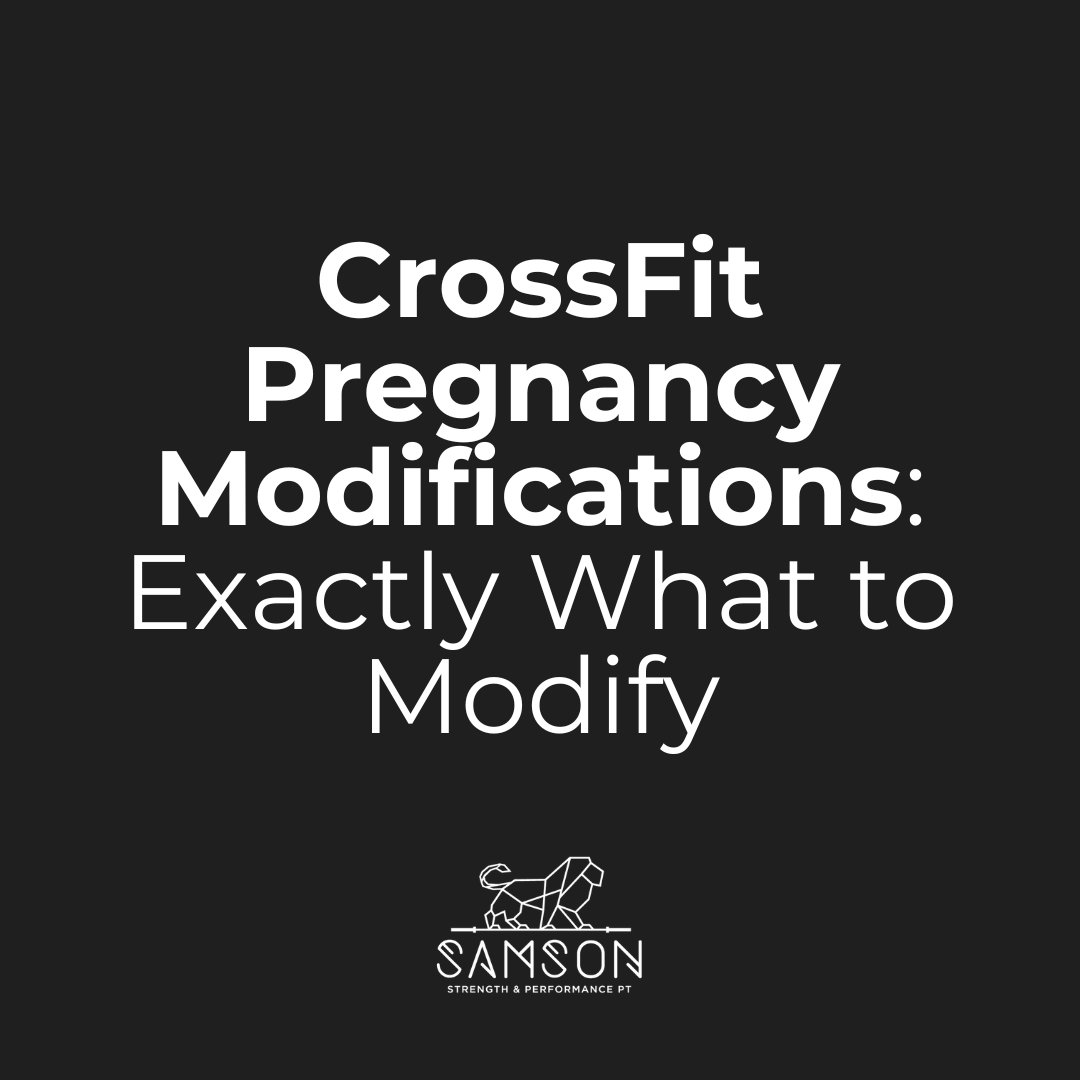CrossFit Pregnancy Modifications: Exactly What to Modify
CrossFit Pregnancy Modifications: Exactly What to Modify
CrossFit is known for its intense and varied workouts, combining weightlifting, gymnastics, and high-intensity interval training to push the limits of strength, endurance, and overall fitness.
However, when you’re pregnant, your body goes through significant changes that can impact your ability to engage in these high-intensity exercises in exactly the same manner.
Fortunately, recent research and expert recommendations have helped clarify how to modify CrossFit training during pregnancy to ensure both mother and baby stay safe while still maintaining fitness.
Consult Your Healthcare Provider First
Before making any adjustments to your CrossFit routine, it’s essential to consult with your healthcare provider.
Pregnancy is not a one-size-fits-all experience, and what works for one woman might not work for another. It is most often recommended that if you are seeking to continue a level of activity that your body is already used to, it is generally safe and recommended to continue the routine.
In the early stages, your doctor can give you a clear idea of what’s safe based on your specific health, pregnancy risk factors, and fitness level. Otherwise, women should not be afraid to continue their normal crossfit routine.
Monitor Intensity and Duration
Pregnancy comes with hormonal changes and physical challenges like increased blood volume and changes in your center of gravity. Research from the American College of Obstetricians and Gynecologists (ACOG) and other studies has consistently recommended reducing the intensity and duration of workouts as pregnancy progresses if you are not used to higher intensity workouts.
Intensity: High-intensity intervals may need to be modified, especially as pregnancy progresses. Studies suggest that moderate-intensity exercise is generally safe and beneficial, while high-intensity exercise can increase the risk of overheating, dehydration, and injury.
For example, research emphasized that pregnant women should aim for a rating of perceived exertion (RPE) of 12–14 on a scale of 6–20, which equates to moderate intensity. This will look different for every individual as every pregnant woman has different levels of fitness tolerance.
Duration: In the second and third trimesters, aim for shorter sessions with longer rest periods to avoid excessive fatigue. Workouts longer than 45 minutes may need to be broken into shorter, more manageable segments.
Modify the Core Workouts
One of the most common concerns with CrossFit during pregnancy is how core exercises impact both the growing baby and your body’s changing biomechanics.
Avoid Overloading the Core: While strengthening the core is essential, pregnant women may need to avoid exercises that involve excessive intra-abdominal pressure, like heavy overhead lifts, or exercises that require a lot of twisting and rotational movements if it presents with abdominal coning/doming.
Research in Sports Medicine (2017) suggests that exercises like sit-ups or heavy barbell work could strain the linea alba (the connective tissue in the abdominal wall) and contribute to diastasis recti, a condition where the abdominal muscles separate. Instead, consider safer core exercises such as modified planks, pallof press, resisted marches, which engage the transverse abdominis without placing undue strain on the abdominal wall.
Pelvic Floor Health: The pelvic floor can become tired more quickly during pregnancy due to hormonal changes and increased pressure from the growing uterus. Research suggests incorporating exercises that strengthen the pelvic floor muscles, such as pelvic floor muscle training or controlled breathing techniques, to counteract this.
Additionally, exercises like deep squats or modified glute bridges can help strengthen these muscles without putting too much strain on them.
Avoid Certain Lifts and Movements
Some movements, especially those that involve heavy lifting or require balance, need to be altered or avoided during pregnancy due to safety concerns.
Reduce Risk of Falling: Movements that increase the risk of falling, such as rope climbs or high-intensity sprints, should be avoided during pregnancy. Your body's natural shift in center of gravity can make these movements more challenging and risky, especially in the later stages of pregnancy. Even a minor trip or stumble can result in a more significant fall than before pregnancy, possibly leading to injuries like sprains, fractures, or back pain.
CrossFit often incorporates movements that require dynamic balance (think box jumps or double-unders). As pregnancy progresses, your center of gravity changes, which can impact balance.
In the third trimester, studies suggest women should modify movements that challenge stability extensively, and make sure to have another person supervise in case of a fall. Modifications for these can include low-impact options, such as air squats, lunges, and wall balls.
Hydration and Temperature Regulation
Maintaining hydration and avoiding overheating is critical, particularly as your body’s capacity for thermoregulation changes during pregnancy. A study in 2016 highlighted that overheating can lead to complications such as preterm labor, so it’s important to modify workouts to avoid excessive heat buildup.
Stay Hydrated: Drink plenty of water before, during, and after exercise to prevent dehydration. Aim for water breaks every 10–15 minutes during high-intensity workouts, and avoid exercising in excessively hot or humid conditions.
Cool Down: Incorporate longer cool-downs with gentle stretching, and if you feel overheated or dizzy, stop immediately and rest in a cool environment.
Rest and Recovery Are Key
Pregnancy requires more recovery time.
A 2020 study published in Frontiers in Sports found that adequate rest and sleep during pregnancy are crucial for maintaining both maternal health and fetal development. CrossFit is intense, but during pregnancy, your body might need more time to recover.
Listen to Your Body: Above all, pay attention to how your body feels. If you experience pain, dizziness, or significant shortness of breath, these are signs that you may need to reduce the intensity or stop the workout.
Strengthen the Upper Body
Maintaining strength in the upper body is essential for managing the physical demands of pregnancy. As the belly grows, core strength changes, and upper body strength can help support the extra weight.
Focus on upper body workouts like push-ups, pull-ups, and kettlebell work to maintain strength and support your posture.
Conclusion
CrossFit can still be a safe and effective workout during pregnancy, modifications might occur to prioritize the health and safety of both the mother and baby.
By reducing intensity, modifying core exercises, avoiding risky movements, staying hydrated, and ensuring sufficient rest, pregnant women can continue to enjoy fitness while protecting their bodies during this transformative time.
Always remember that pregnancy is unique, and it’s important to consult with your healthcare provider before making any major changes to your workout routine.
With the right adjustments, CrossFit can continue to be a part of your fitness journey while ensuring a safe and healthy pregnancy.
References:
American College of Obstetricians and Gynecologists. (2020). Physical Activity and Exercise During Pregnancy and the Postpartum Period.
Journal of Sports Science & Medicine. (2015). Impact of Resistance Exercise on Pregnancy Outcomes.
Sports Medicine. (2017). Core Stability in Pregnancy: The Role of Exercise.
Temperature. (2016). The Effect of Heat on Maternal and Fetal Health During Pregnancy.
Journal of Physical Activity and Health. (2018). Exercise Intensity and Pregnancy: What’s Safe?
Looking for pelvic floor physical therapy in Jacksonville Beach, FL?
If you’re looking for personalized, one-on-one sessions to address your pelvic floor concerns, we provide pelvic health physical therapy services to women in the Jacksonville Beach area.
If you’re looking for providers who will listen to you and help you get to the root cause of your pelvic concerns, we’ve got you. We’re here to help you if you’re experiencing pelvic pain, pelvic heaviness, leaking, or are pregnant/postpartum and want to continue safely working out/running/lifting during your pregnancy and get back to your sport after birth.
Get started today by booking a discovery call.

